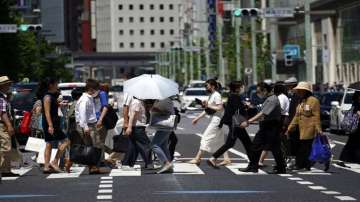Scientists suggest strategies for safe-reopening of economy post lockdown
Scientists have recommended three strategies, including a cycle of lockdown and relaxation, for the safe reopening of economies in low and middle-income countries after months of strict social distancing in response to the COVID-19 pandemic.

Scientists have recommended three strategies, including a cycle of lockdown and relaxation, for the safe reopening of economies in low and middle-income countries after months of strict social distancing in response to the COVID-19 pandemic. According to the research, published in the European Journal of Epidemiology, the three strategies include continued enforcement of basic prevention measures like mask-wearing, physical distancing, and isolation of positive cases after testing.
The researchers, including Rajiv Chowdhury from the University of Cambridge in the UK, said zonal lockdowns which involves "identifying and cordoning off" new clusters of the disease outbreak, and rolling lockdowns which are intermittent implementation of stay-at-home orders followed by a period of relaxation, are also effective.
"Successfully re-opening a country requires consideration of both the economic and social costs. Governments should approach these options with a mind-set that health and economy both are equally important to protect -- reviving the economy should not take priority over preserving people's health," Chowdhury said.
According to the scientists, high-income countries have the capacity to implement mass testing, population surveillance, and case isolation to contain the epidemic, in addition to a high number of trained contact tracers operating in a relatively small and sparse population.
They said these countries have high levels of adherence to the measures, including home quarantine and hygiene advice.
On the contrary, in low- and middle-income countries, or LMICs, they said a sustained mitigation-only approach may be unfeasible due to poor or absent nationwide population surveillance, contact tracing, testing infrastructure, and critical care.
Citing an example, they said LMICs generally have limited supply of ventilators, personal protective equipment, trained healthcare personnel and safe working conditions, compromising the healthcare system's effectiveness.
So the researchers said these measures need to be coupled with zonal and rolling lockdown measures in low- and middle-income countries.
When implementing zonal lockdowns, they said governments should identify and isolate new outbreak clusters with a high number of cases, keeping the contact between zones low.
But the scientists said this requires regular data feedback in real time to identify hotspots, including information on newly confirmed cases.
They said this may be difficult due to the absence of widespread testing in LMICs coupled with poor infrastructure to survey random selections of the population.
Control of transmission within these zones may be an enormous challenge, the researchers said.
Citing an example of this limitation, they said in India, where a similar approach has been employed, the infection size within some cordoned zones is "as high as 100-200 times that outside the zone."
According to the researchers, countries seeking to introduce such measures should establish within the lockdown zone public health measures such as house-to-house surveillance and case-referral systems, and emergency services.
They said these countries should also create buffer zones to reduce the rates of transmission from outside the zone, adding that such measures may only be effective when overall population transmission is relatively low and reducing.
Commenting on rolling lockdowns, they said these involve implementing strict social distancing for a set number of days before a period of relaxation.
Rolling lockdowns, according to the study authors, may be particularly useful in LMICs with dense populations, where this is a high potential for contact, weak health systems, and poor contact tracing.
They said a system involving 50 days of strict lockdown followed by 30 days of relaxation can enable the economy to 'breathe' and recuperate, while reducing spread of the disease and strain on health systems.
Such a measure, according to the scientists, can considerably reduce the number of deaths compared to a situation with no lockdown.
However, they cautioned that the measure should be customised for different regions.
"Rolling lockdowns need be flexible and tailored to the specific country. The frequency and duration of the lockdowns or relaxed periods should be determined by the country based on local circumstances," explained Oscar Franco from the University of Bern in Switzerland and senior author of the study.
"They don't necessarily need to be nationwide -- they can also involve a large zone or province with very high incidence of COVID-19," Franco said.
The scientists concluded that the three strategies should not be considered as one or the other.
"A country should further adapt and could combine them as needed," said Shammi Luhar, another co-author of the study from the University of Cambridge.